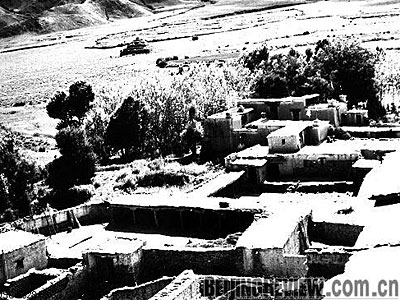|
 |
|
LITTLE REFUGE: Shabby and dilapidated houses once lived in by Tibetan serfs (XINHUA) |
Tibetan legislators have endorsed a bill designating March 28 as an annual Serfs' Emancipation Day. The motion was unanimously passed at the Second Session of the Ninth People's Congress of the Tibet Autonomous Region on January 19, 2009.
Serfs' Emancipation Day was set up to mark the liberation of about 1 million serfs in Tibet 50 years ago. On March 28, 1959, the late Premier Zhou Enlai promulgated a State Council decree to dissolve the local Tibetan government that was the keeper of the feudal serfdom system. The decree was issued after the People's Liberation Army (PLA) quelled the rebellion in Lhasa staged by some people in the upper ruling strata to seek "independence" for Tibet.
The decree ushered in a new era for Tibet. After it was issued, serfs were freed and given cultivated land and cattle for the first time in their lives, and the people's democratic reform was launched in the region.
Unequal society
Before 1959, Tibet was a feudal serfdom society under theocratic rule. In the old days, high-ranking lamas in the monasteries, nobles and local officials formed the serf-owner class. Although they accounted for only 5 percent of the total Tibetan population, they possessed all the farmland, pastures, forests, mountains and rivers, and most of the livestock.
Serf owners controlled the personal freedom of serfs and slaves, who made up more than 95 percent of the population, and could give them as gifts, trade them or use them as mortgages. Serfs had to pay exorbitant taxes and levies and those who defied the control of their owners were severely punished.
Democratic reform
On May 23, 1951, the Central Government and the local Tibetan government signed the Agreement of the Central People's Government and the Local Government of Tibet on Measures for the Peaceful Liberation of Tibet, also known as the 17-Article Agreement. Tibet was thus liberated peacefully. The PLA entered Tibet and completely expelled imperialist powers.
Although a key mission of the revolution in China was to abolish feudalism and let all people in the country advance into socialism, given Tibet's special situation, the Central Government adopted a circumspect attitude toward the reform of the social system in Tibet, patiently persuading and giving local authorities adequate time for the reform.
The reform of the social system in Tibet is clearly defined in the 17-Article Agreement. Article 11 provides, "In matters related to various reforms in Tibet, there will be no compulsion on the part of the Central Authorities. The local government of Tibet shall carry out reforms voluntarily, and when the people raise demands for reform, they shall be settled by means of consultation with the leading personnel of Tibet."
The peaceful liberation strengthened the political, economic and cultural links between Tibet and other parts of China, and woke up the serfs' desire to reform by abolishing feudal serfdom system.
In 1955, democratic reform was launched in Tibetan-inhabited areas in several provinces such as Gansu, Qinghai, Sichuan and Yunnan. But some upper-class Tibetans in these areas were reluctant to give up their privileges. They were diehard supporters of the feudal system. In order to preserve feudal serfdom, they staged armed rebellions. As their rebellions were suppressed, these rebels fled into Tibet. The local Tibetan government condoned these rebels, and supported them with weapons and personnel. Some foreign forces hostile to China also actively supported the rebels. The Central Intelligence Agency of the United States offered military training to the rebels. Full-scale rebellion broke out in Tibet on March 10, 1959.
On that day, more than 1,000 people demonstrated on the streets of Lhasa, chanting such slogans as "free Tibet." More than 100 representatives of the rebel force convened a meeting, and decided to launch the "Tibet Independence Movement." On March 13, the headquarters of the rebellion force issued an order, rallying all Tibetan males between the ages of 18 and 60 to take up arms and come to Lhasa immediately. On March 20, the rebellion force stormed the Party, government and army institutions in Lhasa.
These upper-class Tibetan rebels wrongfully estimated the situation, and went against the will of the general public. As a result, they were rejected by the people in Tibet and in other parts of China. After shots were fired in Lhasa on March 20, the PLA put down the rebellion in just two days. On March 28, the State Council issued an order to dissolve the local Tibetan government. In the following two years, the army quenched the rebellion in other places in Tibet.
From 1959 to 1961, an earth-shattering democratic reform was launched all over Tibet. The 1 million or so serfs toppled the dark rule of their owners and abolished the feudal theocratic system. The people's democratic system was established.
With the democratic reform, the Tibetan people have established political institutions of their own, obtained their own production materials and enjoyed freedom as the masters of the country.
The author is a research fellow and Secretary General of the China Tibetology Research Center | 